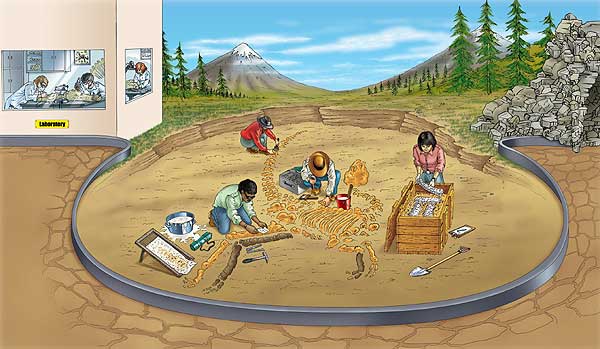First Things First
by Creation Museum on November 25, 2003Where do you begin—in life, in decisions, in finding answers—or in the world’s most unusual museum, now under construction near Cincinnati?
At other museums, the first exhibits are fairly routine. Perhaps a terrifying dinosaur that supposedly lived 300 million years ago, or a “time display” that shows man’s existence as a fleck of paint at the end of the yardstick of time.
The first exhibit is the key to every museum, laying the foundation to the message of the rest of the museum. The ultimate goal of most museums is to subtly indoctrinate guests in the “fact” of natural history that stretches for millions of years, without ever honestly admitting this goal.
The first exhibit is pretty important.
Presumptuous presuppositions
So where should AiG begin its “answers” museum?
Answers in Genesis is all about beginnings—especially the Book of Genesis. Yet before guests begin their “walk through the 7 C’s of biblical history”—before they see Adam naming the dinosaurs or Cain’s descendants mocking a worldwide Flood, guests need to dig a little deeper, into the recesses of their own minds.
They need to look into their hearts, where they’ll find the root issue in today’s battle for biblical history.
Why don’t modern people—including many Christians—believe the plain teaching of Scripture about God’s creation and man’s early history? Why do they believe the prevailing evolutionary view about life on earth millions of years ago?
The answer is their starting points (or technically, their “presuppositions”—things we accept as true without proof).
When guests come to AiG’s Creation Museum, the first thing they will see, after they pass through the lobby and walk through the turnstile, is an eye-catching display of the world we see today (soaring rock layers, a huge dinosaur dig site, etc.)—along with questions, lots of questions.
If the rest of the museum is going to have any impact, the first thing that guests must recognize is the critical role of “starting points” in our thinking.
The dig site

So the first thing that guests will see in the Creation Museum is not a Bible display or a scene from the Garden of Eden. No, they’ll wind through a narrow gorge in the Grand Canyon, which will then open into a large open space—a huge fossil dig, with paleontologists uncovering the bones of a massive 30-foot stegosaur.
All around are scattered examples of fossils and artifacts we find today, with questions attached: “Rock layers—a long time and a little water, or a lot of water and a little time?” “Footprints—humans or our apelike ancestors?” “Cave art—the work of prehistoric brutes or modern humans?” and so on.
Meanwhile, guests will see two paleontologists on their hands and knees, carefully working on the stegosaur. One scientist believes in biblical creation and the other believes that dinosaurs died millions of years ago. Both will explain the work that they’re doing.
Behind them on the screen will appear striking images of past volcanoes, earthquakes, floods, etc. The video will display the shocking contrast between what paleontologists know about fossils today and what they reconstruct based on their own starting points.
The point of the exhibit is clear: what are our starting points? This dig exhibit is the key to the Creation Museum—“the world’s most unusual museum.” It is the key to giving answers that will confront our culture, pry open the door of skeptics’ hearts to the gospel, and challenge believers to let God’s Word be the authority in every area of their lives (including their understanding of history, science and the world around them).
Starting points
Few people realize the critical role that beliefs play in reconstructing our past. Fossils don’t come with labels on them saying, “I’m 250 million years old.”
Unlike other sciences, such as “rocket science” that puts men on the moon or “food science” that puts pasteurized milk in our refrigerators, historical science cannot repeat and test in the laboratory. Historical events cannot be repeated.
Museum guests will begin to see the assumptions that geologists, paleontologists and other “historical scientists” must make—assumptions about how rock layers are formed, assumptions about how radioactive elements break down over time (e.g. dating techniques), and so on.
Reaching correct conclusions about ancient history requires the correct starting point.
What assumptions do scientists make when they talk about events “hundreds of millions of years ago”? Do they have the right starting point? Is there a better starting point that makes more sense of the world we see today?
The first exhibit at the Creation Museum will challenge guests to begin evaluating the very deepest thoughts of their hearts. Our aim, by God's grace, is a complete revolution in the hearts of our guests, a change of heart and mind that will change their lives forever.
It won’t be easy. But it all begins with the heart.
What will be the next surprising exhibit in the world’s most unusual museum?y tuned.